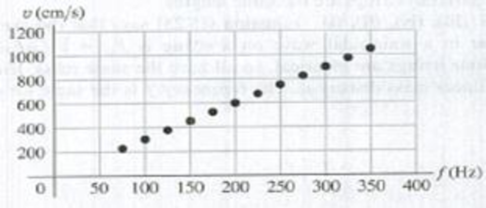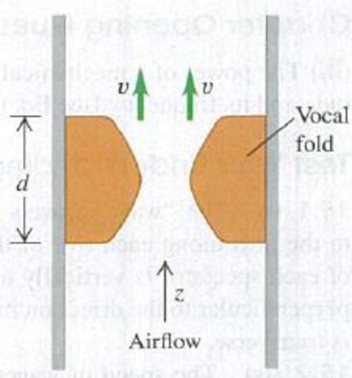
Concept explainers
BIO WAVES ON VOCAL FOLDS. In the larynx, sound is produced by the vibration of the vocal folds (also called “vocal cords”). The accompanying figure is a cross section of the vocal tract at one instant in time. Air flows upward (in the +z-direction) through the vocal tract, causing a transverse wave to propagate vertically upward along the surface of the vocal folds. In a typical adult male, the thickness of the vocal folds in the direction of airflow is d = 2.0 mm. High-speed photography shows that for a frequency of vibration of f = 125 Hz, the wave along the surface of the vocal folds travels upward at a speed of v = 375 cm/s. Use t for time, z for displacement in the +z-direction, and λ for wavelength.
15.78 What is the wavelength of the wave that travels on the surface of the vocal folds when they are vibrating at frequency f? (a) 2.0 mm; (b) 3.3 mm; (c) 0.50 cm; (d) 3.0 cm.
15.79 Which of these is a possible mathematical description of the wave in Problem 15.78? (a) A sin[2πf(t + z/v)]; (b) A sin[2πf(t − z/v)]; (c) A sin(2πft)cos(2πz/λ); (d) A sin(2πft)sin(2πz/λ).
15.80 The wave speed is measured for different vibration frequencies. A graph of the wave speed as a function of frequency (Fig. P15.80) indicates that as the frequency increases, the wavelength (a) increases; (b) decreases; (c) doesn’t change; (d) becomes undefined.
Figure P15.80


Want to see the full answer?
Check out a sample textbook solution
Chapter 15 Solutions
University Physics with Modern Physics Plus Mastering Physics with eText -- Access Card Package (14th Edition)
Additional Science Textbook Solutions
Physics (5th Edition)
University Physics Volume 2
Conceptual Physical Science (6th Edition)
The Cosmic Perspective (8th Edition)
Introduction to Electrodynamics
Tutorials in Introductory Physics
- A sound wave in air has a pressure amplitude equal to 4.00 103 Pa. Calculate the displacement amplitude of the wave at a frequency of 10.0 kHz.arrow_forwardThe equation of a harmonic wave propagating along a stretched string is represented by y(x, t) = 4.0 sin (1.5x 45t), where x and y are in meters and the time t is in seconds. a. In what direction is the wave propagating? be. N What are the b. amplitude, c. wavelength, d. frequency, and e. propagation speed of the wave?arrow_forwardFemale Aedes aegypti mosquitoes emit a buzz at about 4.00102 Hz, whereas male A. aegypti mosquitoes typically emit a buzz at about 6.00102 Hz. As a female mosquito is approaching a stationary male mosquito, is it possible that he mistakes the female for a male because of the Doppler shift of the sound she emits? How fast would the female have to be traveling relative to the male for him to make this mistake? Assume the speed of sound in the air is 343 m/s.arrow_forward
- Three metal rods are located relative to each other as shown in Figure P17.68. where Ls = L1 + L2. The speed of sound in a rod is given by = Y/p, where Y is Youngs modulus for the rod and is the density. Values of density and Young's modulus for the three materials are 1 = 2.70 X 103 kg/m3, Y1 = 7.00 1010 N/m, 2 = 11.3 103 kg/m3, = 1.60 1010 N/m2. s = 8.80 103 kg/m3 Ys = 11.0 1010N/m2. If L3 = 1.50m, what must the ratio L1/L2if a sound wave is to travel the length of rods 1 and 2 in the same time interval required for the wave to travel the length of rod 3?arrow_forwardThe bulk modulus of water is 2.2 109 Pa (Table 15.2). The density of water is 103 kg/m3 (Table 15.1). Find the speed of sound in water and compare your answer with the value given in Table 17.1.arrow_forwardRank the waves represented by the following functions from the largest to the smallest according to (i) their amplitudes, (ii) their wavelengths, (iii) their frequencies, (iv) their periods, and (v) their speeds. If the values of a quantity are equal for two waves, show them as having equal rank. For all functions, x and y are in meters and t is in seconds. (a) y = 4 sin (3x 15t) (b) y = 6 cos (3x + 15t 2) (c) y = 8 sin (2x + 15t) (d) y = 8 cos (4x + 20t) (e) y = 7 sin (6x + 24t)arrow_forward
- Some studies suggest that the upper frequency limit of hearing is determined by the diameter of the eardrum. The wavelength of the sound wave and the diameter of the eardrum are approximately equal at this upper limit. If the relationship holds exactly, what is the diameter of the eardrum of a person capable of hearing 20 000 Hz? (Assume a body temperature of 37.0C.)arrow_forwardA pipe is observed to have a fundamental frequency of 345 Hz. Assume the pipe is filled with air (v = 343 m/s). What is the length of the pipe if the pipe is a. closed at one end and b. open at both ends?arrow_forwardThe area of a typical eardrum is about 5.00 X 10-5 m2. (a) (Calculate the average sound power incident on an eardrum at the threshold of pain, which corresponds to an intensity of 1.00 W/m2. (b) How much energy is transferred to the eardrum exposed to this sound lor 1.00 mill?arrow_forward
- The tensile stress in a thick copper bar is 99.5% of its elastic breaking point of 13.0 1010 N/m2. If 500-Hz sound wave is transmitted through the material, (a) what displacement amplitude will cause the bar to break? (b) What is the maximum speed of the elements of copper at this moment? (c) What is the sound intensity in the bar?arrow_forwardAs in Figure P18.16, a simple harmonic oscillator is attached to a rope of linear mass density 5.4 102 kg/m, creating a standing transverse wave. There is a 3.6-kg block hanging from the other end of the rope over a pulley. The oscillator has an angular frequency of 43.2 rad/s and an amplitude of 24.6 cm. a. What is the distance between adjacent nodes? b. If the angular frequency of the oscillator doubles, what happens to the distance between adjacent nodes? c. If the mass of the block is doubled instead, what happens to the distance between adjacent nodes? d. If the amplitude of the oscillator is doubled, what happens to the distance between adjacent nodes? FIGURE P18.16arrow_forwardWhen all the strings on a guitar (Fig. OQ13.5) are stretched to the same tension, will the speed of a wave along the most massive bass string be (a) faster, (b) slower, or (c) the same as the speed of a wave on the lighter strings? Alternatively, (d) is the speed on the bass string not necessarily any of these answers? Figure OQ13.5arrow_forward
 Physics for Scientists and Engineers: Foundations...PhysicsISBN:9781133939146Author:Katz, Debora M.Publisher:Cengage Learning
Physics for Scientists and Engineers: Foundations...PhysicsISBN:9781133939146Author:Katz, Debora M.Publisher:Cengage Learning Principles of Physics: A Calculus-Based TextPhysicsISBN:9781133104261Author:Raymond A. Serway, John W. JewettPublisher:Cengage Learning
Principles of Physics: A Calculus-Based TextPhysicsISBN:9781133104261Author:Raymond A. Serway, John W. JewettPublisher:Cengage Learning Physics for Scientists and Engineers, Technology ...PhysicsISBN:9781305116399Author:Raymond A. Serway, John W. JewettPublisher:Cengage Learning
Physics for Scientists and Engineers, Technology ...PhysicsISBN:9781305116399Author:Raymond A. Serway, John W. JewettPublisher:Cengage Learning Glencoe Physics: Principles and Problems, Student...PhysicsISBN:9780078807213Author:Paul W. ZitzewitzPublisher:Glencoe/McGraw-Hill
Glencoe Physics: Principles and Problems, Student...PhysicsISBN:9780078807213Author:Paul W. ZitzewitzPublisher:Glencoe/McGraw-Hill University Physics Volume 1PhysicsISBN:9781938168277Author:William Moebs, Samuel J. Ling, Jeff SannyPublisher:OpenStax - Rice University
University Physics Volume 1PhysicsISBN:9781938168277Author:William Moebs, Samuel J. Ling, Jeff SannyPublisher:OpenStax - Rice University




